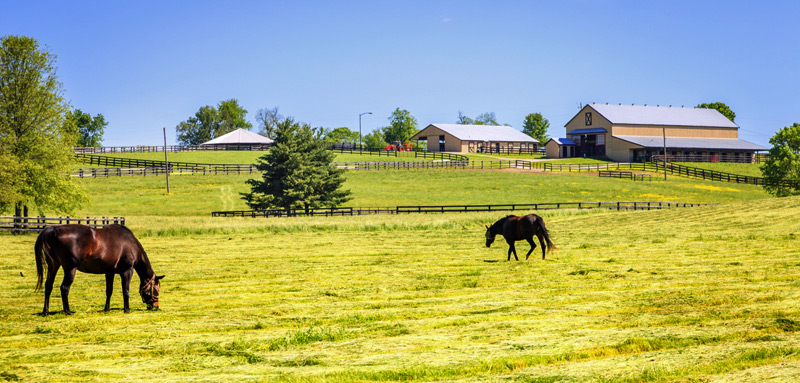
Many domestic horses live a life of luxury compared to their wild cousins. While a cozy, well-bedded stall might seem like the perfect environment, staying in a barn much of the time is not how horses were intended to live. Provide plenty of turn-out time and learn how to keep your stabled horse happy and healthy by paying attention to these basic considerations.
Respiratory Issues
Prior to building a barn is the time to think about how design affects ventilation. Doors, vents, louvers, open stall fronts, windows and overall barn design all impact how air moves through the barn. Ventilation works from bottom to top, not from side to side. There must be an opening(s) at the top of the barn, but to get air moving, there must also be openings just above ground level. These openings allow cooler air to enter and push the warm, stale air up and out.
Keep in mind that a snug, closed-up barn might feel good to you, but it’s not healthy for your horse. Even in cold weather, you want to do everything possible to promote good air flow by strategically opening doors, windows (and louvers, if applicable).
“A major concern is making sure that there are enough air exchanges to keep the air fresh,” says Bob Coleman, PhD, extension horse specialist at the University of Kentucky. “Too often when the weather turns bad, we close up the barn to keep it warm and by doing that we restrict the flow of fresh air into the barn. This leaves the stale air in the barn and ammonia, dust and water vapor all affect the horse’s respiratory system.”
By their very nature, bedding and hay can be dusty. This can cause problems, even if the barn itself has great ventilation.
“A lot of people underestimate the amount of dust in the horse’s bedding and hay. In managing inflammatory airway cases, the two biggest areas we focus on are bedding and hay,” notes Carol Clark, DVM, DACVIM, of Peterson & Smith Equine Hospital in Ocala, Florida.
When feeding hay, use a feeder that allows the horse to eat with his head lowered. You don’t want the horse eating from a high hay net or wall-mounted feeder with his head up because, in this position, he’s inhaling dust and hay particles. If you feed on the stall floor, make sure to use a rubber mat so the horse isn’t eating directly off the ground.
In some cases, owners choose to replace hay completely with one of the bagged forage products that are now popular. These products feature kiln-dried forage with a small amount of oil and/or molasses added. They contain absolutely no dust and some brands also have lower amounts of starch, if that is a concern.
Buy the least dusty bedding possible and remove the horse from the stall when you clean it. If bedding appears dusty when you’ve finished cleaning, lightly mist it with water and let things settle before bringing the horse back into the stall.
“Don’t use a mechanical blower in the barn aisle way,” adds Clark. “This gets dust everywhere. Anything that will stir up dust is not a good idea to use.”
Controlling Contagious Disease
Just like kids sharing germs in school, a contagious disease can spread easily to other horses in the barn if you aren’t careful.
For starters, Coleman recommends making sure all horses are on a regular vaccination program. Your veterinarian will tailor this to your area and the horses’ risk of exposure.
“Respiratory diseases can travel through the barn when the horses cough or sneeze,” he cautions. “Horse owners need to be able to isolate a horse that is sick at one end of the barn away from other horses, and then make sure that they are not sharing buckets or equipment.”
Whenever a new horse arrives at the farm, it should be isolated from the current equine population. During the isolation period, take care of resident horses first, then new horses, to prevent the possible transfer of germs or bacteria. Don’t share grooming supplies, buckets, thermometers, tack or equipment between new horses and current horses during the isolation period.
If you don’t have a separate barn, put the new arrival(s) in a stall(s) at one end of the barn where they’re distanced by a feed/tack room or several empty stalls. If this isn’t possible, at the very least, keep the new horse(s) in a separate paddock so they aren’t drinking and eating with the resident horses right away.
Monitor new horses for anything out of the ordinary, such as fever, nasal discharge, cough, lack of or decrease in appetite, lethargy or depression. Contact your veterinarian if you notice any of these.
Ideally, you should keep new horses separate for at least two—preferably three—weeks. After 21 days, if there is no sign of illness, you should be able to safely integrate them in with the resident horses.
Liked this article? Here are others you’ll love:
Heaves in Horses
Biosecurity Tips for Horse Owners






Exactly the way my Dad taught me growing up on our Dairy Farm, He even put a fan, in the top of the barn, blowing out the other door, not causing any dust to fly etc. just circulate air, and we had two huge doors at North and South Ends of our barn, usually open all the time. He taught me a lot about care, he was born in 1920 so he grew up with horses, working horses, caring horses. He had a American Saddlebred Gelding the first one I remember, he raised him. We had a Dairy, but ended selling cows and Raising Reg Quarter Horses for many years, I had a grandaughter of 3Bars. She was a nice 14.3 size for me. I kept her til she got old.